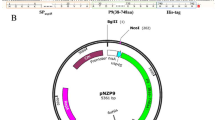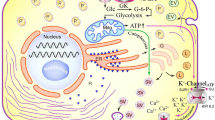Summary
The effect of several methylputrescines on the activity of insulin-induced ornithine decarboxylase (ODC) was examined in H-35 hepatoma cells. The induction involved both protein and m-RNA synthesis. Actinomycin D inhibited ODC activity when given up to 1 h after insulin treatment. When added to the medium 2 h or 3 h after the insulin, the activity was increased 100% and 80% respectively. Insulin-induced ODC from H-35 cells had a biphasic half-life, a shorter one of 46 min and a longer one of 90 min.
1-Methylputrescine and 2-methylputrescine were found to be competitive inhibitors of the ODC from H-35 cells with Ki values of 2.8 and 0.1 mM respectively. Putrescine itself was found to have a Ki = 2.4 mM. N-Methylputrescine was a very poor inhibitor of the cell free ODC while 1,4-dimethylputrescine did not show any inhibitory effect. When cellular ODC activity was measured, the four methylputrescines assayed as well as putrescine entirely abolished its activity in the H-35 cells when given at a 1 mM concentration together with insulin. 1-Methylputrescine and 1,4-dimethylputrescine abolished 60% of the activity at a 0.1 µM concentration. All the methylputrescines given at 0.1 mM concentrations decreased the putrescine content of the stimulated cells to the levels found in quiescent cells, but only 1-methyl and 2-methylputrescines decreased spermidine and spermine content. 1,4-Dimethyl and 1-methylputrescines showed a strong inhibition of ODC synthesis, while the other diamines were less inhibitory. At concentrations that abolished ODC activity, 1,4-dimethylputrescine decreased 70% of the total immunoreactive ODC bands, while 1-methyl and 2-methylputrescine decreased them by 50%, and N-methylputrescine and putrescine decreased them by 20%. The lack of decrease in immuno-reactive ODC with the latter two compounds was mainly due to the appearance of immunoreactive degradation products of ODC of low molecular weight. Putrescine and N-methylputrescine affected protein synthesis to a small extent in stimulated cells, while 1-methylputrescine decreased it to the level of non-stimulated cells. Insulin (1 µM concentration) stimulated DNA synthesis in the cells, and this stimulation was doubled in the presence of 2-methylputrescine or putrescine. It can be concluded that, among the methylputrescines assayed, 2-methylputrescine was the best inhibitor of cell-free ODC activity, while 1,4-dimethylputrescine and 1-methylputrescine were the best inhibitors of cellular ODC activity.
Similar content being viewed by others
Abbreviations
- ODC:
-
Ornithine Decarboxylase
- TLC:
-
Thin Layer Chromatography
- DNEM:
-
Dulbecco's Modified Essential Medium
- PBS:
-
Phosphate Buffered saline
- PEG:
-
Polyethyleneglycol
References
Tabor CW, Tabor H: Polyamines, Ann Rev Biochem 53: 749–790, 1984
Bachrach U, Kaye A, Chayen R: Advances in Polyamine Research, Raven Press, (eds.) New York, 1983, 4
McCann PP: Regulation of ornithine decarboxylase in eukaryotes. In: JM Gaugas (ed) Polyamines in Biomedical Research. J. Wiley and Sons, Chichester, 1980, pp 109–123
Fong WF, Heller IS, Canellakis ES: The appearance of an ornithine decarboxylase inhibitory protein upon the addition of putrescine to cell cultures. Biochim Biophys Acta 428: 456–462, 1976
Murakami Y, Hayashi S: Role of antizyme in degradation of ornithine decarboxylase in HTC cells. Biochem J 226: 893–900, 1985
Metcalf BB, Bey P, Danzin C, Jung MJ, Casara P, Veverti JP: Catalytic irreversible inhibition of mammalian ornithine decarboxylase. J Am Chem Soc 100: 2551–2553, 1978
Danzin C, Bey P, Schirlin D, Claverie α-Monofluoromethyl and α-difluoromethyl putrescine as ornithine decarboxylase inhibitors: In vitro and in vivo biochemical properties. Biochem Pharmac 31: 3871–3878, 1982
Danzin Ch, Mamont PS: Polyamine inhibition in vivo and in organ growth and repair. In: PP McCann, AE Pegg, A Sjoerdsma (eds.). Inhibition of Polyamine Metabolism, Academic Press, New York, 1987, pp. 141–164.
Porter CW, McMannis J, Casero RA, Bergeron RJ: The relative abilities of bis(ethyl)derivatives of putrescine, spermidine and spermine to regulate polyamine biosynthesis and inhibit cell growth. Cancer Res 47: 2821–2827, 1987
Bergeron RJ, Neims AH, McManis JS, Hawthorne ThR, Vinson JRT, Portell R, Ingeno MJ: Synthetic polyamine analogues as antineoplastics. J Med Chem 31: 1183–1190, 1988
Mamont PS, Bohlen P, McCann PP, Bey P, Schuber F, Tardif C: α-Methyl ornithine, a potent competitive inhibitor of ornithine decarboxylase, blocks proliferation of rat hepatoma cells in culture. Proc Natl Sci, USA 73; 1626–1630, 1976
Ruiz O, Alonso Garrido DO, Buldain G, Frydman RB: Effect of N-alkyl and C-alkylputrescines on the activity of ornithine decarboxylase from rat liver and E. coli. Biochim Biophys Acta 873, 53–61, 1986
Ruiz O, Buldain G, Alonso Garrido DO, Frydman RB: Interaction of alkylputrescines with ornithine decarboxylase from rat liver and E. coli: an in vitro and in vivo study. Biochim Biophys Acta 954: 114–125, 1988
Kelley DS, Becker JE, Potter VR: Effect of insulin, dexamethasone and glucagon on the amino acid transport ability of four rat hepatoma cell lines and rat hepatocytes in culture. Cancer Res 38: 4591–4600, 1978
Munns TW, Johnston MF, Liszewski MK, Olson RE: Vitamin K-dependent synthesis and modification of precursor prothrombin in cultured H-35 hepatoma cells. Proc Natl Acad Sci, USA 73: 2803–2807, 1976
Alonso Garrido DO, Buldain G, Frydman B: Concerning the synthesis of N-methylputrescine and its homologues. J Org Chem 49: 2021–2023, 1984
Alonso Garrido DO, Buldain G, Frydman B: 1,4-Diaminoalkanes from pyrroles. A new synthetic approach to substituted putrescines. J Org Chem 49: 2619–2622, 1984
Alonso Garrido DO, Buldain G, Ojea MI, Frydman B: Synthesis of 2-alkylputrescines from 3-alkylpyrroles. J Org Chem 53: 403–407, 1988
Bradford M: Rapid and sensitive method for quantitation of microgram quantities of protein utilising the principle of protein-dye binding. Anal Biochem 72: 248–254, 1976
Dreyfuss G, Duir R, Harell A, Chayen R: Determination of polyamines in urine. Clin Chim Acta 49: 65–72, 1973
Laemmli UK: Cleavage of structural proteins during the assembly of the head of bacteriophage T4. Nature 227: 680–685, 1970
Bonner WM, Laskey RA: A film detection method for tritium labelled proteins and nucleic acids in polyacrylamide gels. Eur J Biochem 46: 83–88, 1974
Morrissey JH: Silver stain for proteins in polyacrylamide gels: a modified procedure with enhanced uniform sensitivity. Anal Biochem 117: 307–310, 1981
McCann PP, Tardif C, Mamont PS: Regulation of ornithine decarboxylase by ODC-antizyme in HTC cells. Biochim Biophys Res Commun 75: 948–954, 1977
Heller JS, Chen KY, Kyriakidis DA, Fong WF, Canellakis ES: The modulation of the induction of ornithine decarboxylase by spermine, spermidine and diamines. J Cell Physiol 96: 225–234, 1978
Chen KY, Liu AYC: Differences in the mode of regulation of ornithine decarboxylase and tyrosine amino-transferase in H-35 rat hepatoma cells shown by varying the medium composition. Biochim Biophys Acta 755: 244–252, 1983
Bachrach U: Polyamines and neoplastic growth: stabilization of ornithine decarboxylase during transformation. Biochim Biophys Res Commun 72: 1008–1013, 1976
Hollta E, Sistonen L, Alitalo K: The mechanism of ornithine decarboxylase deregulation in C-Ha-ras oncogene transformed NIH 3T3 cells. J Biol Chem 263: 4500–4507, 1988
Epstein D, Elias-Bishko S, Hershko A: Requirement for protein synthesis in the regulation of protein breakdown in cultured hepatoma cells. Biochemistry 14: 5199–5204, 1975
Holm I, Persson L, Heby O, Seiler N: Feedback regulation of polyamine synthesis in Ehrlich ascites tumor cells. Analysis using non-metabolizable derivatives of putrescine and spermine. Biochim Biophys Acta, 972: 239–248, 1988
Kameji T, Pegg AE: Inhibition of translation of mRNAs for ornithine decarboxylase and s-adenosylmethionine decarboxylase by polyamines. J Biol Chem 262: 2427–2430, 1986
Persson L, Holm I, Heby O: Regulation of ornithine decarboxylase mRNA translation by polyamines. J Biol Chem 263: 3528–3533, 1988
Holtta E, Pohjanpelto P: Control of ornithine decarboxylase in chinese hamster ovary cells by polyamines. J Biol Chem 261: 9502–9508, 1986
Rudkin BB, Mamont PS, Seiler N: Decreased proteinsynthesis activity is an early consequence of spermidine depletion in rat hepatoma tissue culture cells. Biochem J 217: 731–741, 1984
Goldemberg SH, Algranati ID, Miret JJ, Alonso Garrido DO, Frydman B: Effect of putrescine derivatives on growth and protein synthesis. In: U Bachrach, A Kaye, R Chayen (eds.) Raven Press, New York. Advances in Polyamine Research, vol. 4, 1984, pp. 233–244.
Mottola C, Czech MP: The type II insulin-like growth factor receptor does not mediate increased DNA synthesis in H-35 hepatoma cells. J Biol Chem 259: 12705–12713, 1984
Granner DK, Hangrove JL: Regulation of the synthesis of tyrosine aminotransferase; the relationship to mRNATAT. Mol Cell Biochem 53/54, 113–128, 1983
Reel JR, Lee KL, Kenney FT: Regulation of tyrosine-ketoglutarate transaminase in rat liver. IX Studies of the mechanism of hormonal induction in cultured hepatoma cells. J Biol Chem 245: 5806–5812
Hiramatsu Y, Oomoto H, Eguchi K, Sekiba K: Regulation of ornithine decarboxylase by various hormones and aminoacids in primary cultured hepatocytes (Abstr.) International Conference on Polyamines in Life Science, Lake Yamanaka, Japan, 1986, pp. 173–174
Clark JL: Specific induction of ornithine decarboxylase in 3T3 mouse fibroblasts by pituitary growth factors: cell-density dependent biphasic response and alteration of half life. Biochemistry 13: 4668–4674, 1974
Astrup EG, Boutwell RK: Ornithine decarboxylase activity in chemically induced mouse skin papillomas. Carcinogenesis 3: 303–308, 1982
Poso H, Karvonen E, Svomalainen H, Anderson LC: A human neuroblastoma cell line with an altered ornithine decarboxylase. J Biol Chem 259: 12307–12310, 1984
Numazawa S, Oguro T, Yoshida T, Karoiva Y: The mode of induction of ornithine decarboxylase by diethylmaleate (Abstr.) International Conference on Polyamines in Life Science, Lake Yamanaka, Japan, 1986, pp. 187–188
Mitchell JLA, Qasba P, Stofko RE, Franzen MA: Ornithine decarboxylase modification and polyamine-stimulated enzyme inactivation in HTC cells. Biochem J 228: 297–308, 1985
Worth LL, Haddox MK: Evidence for activation of ornithine decarboxylase by differential phosphorylation (Abstr.) J Cell Biol 107: 855a
Hogan BLM, Murden S: Effect of growth conditions on the activity of ornithine decarboxylase in cultured hepatoma cells. J Cell Physiol 83: 345–352, 1974
Frydman B, Frydman RB, de los Santos C, Alonso Garrido DO, Goldemberg SH, Algranati IA: Putrescine distribution in E. coli studied in vivo by 13C-NMR. Biochem Biophys Acta 805: 337–344, 1984
Sarhan S, Dezeuve F, Seiler N: Putrescine derivatives as substrates of spermidine synthase. Int J Biochem 19: 1037–1047, 1987
Feuerstein BG. Marton LJ: Specificity and binding in polyamine nucleic acid interaction. In: U Bachrach, YM Heimer (eds.) The Physiology of Polyamines, vol. I, CRC Press, Boca Raton, 1989, pp. 109–124
Quigley GT, Teeter MM, Rich A: Structural analysis of spermine and magnesium ion binding to yeast phenylalanine transfer RNA. Proc Natl Acad Sci USA, 75: 64–68, 1978
Author information
Authors and Affiliations
Rights and permissions
About this article
Cite this article
Frydman, J., Ruiz, O., Robetto, E. et al. Modulation of insulin induced ornithine decarboxylase by putrescine and methylputrescines in H-35 hepatoma cells. Mol Cell Biochem 100, 9–23 (1991). https://doi.org/10.1007/BF00230805
Received:
Accepted:
Issue Date:
DOI: https://doi.org/10.1007/BF00230805




